For this church:    |
|
 The
iron church - the The
iron church - thefirst church on the site |
Work on building the iron church took place during 1883. Since the main part of the site needed to be kept free for building the anticipated permanent church, the mission was erected at the far end of the plot of land, approximately 244 feet back from the road, on what later became allotments. The site is now beneath the easterly end of the housing complex. The church measured 84 feet by 39 feet, with a maximum height of 25 feet 6 inches. It was designed to seat between 450 and 500 people. The interior was boarded throughout, and the building was heated with a gas boiler. The new church, dedicated to St Luke, was opened on Thursday 6 December 1883 by the Bishop of Lincoln.
In 1886 the name of the mission church was changed. The baptism register is endorsed to the effect that, ‘the name of this Mission Church was altered to St Simon’s in November 1886 so as not to confuse with the old church of St Luke’s, Nottingham’.
 The parish room before The parish room beforeits demolition - the current church is behind |
The intention from the outset was that the iron church should be a temporary building, but as northern Hyson Green was a relatively poor area no money was available for erecting a permanent church, although it proved possible in 1888-9 to fund a parish room (now demolished). However, the closure of St Stephen’s, Bunkers Hill, as a result of the clearance of the Charlotte Street area in Nottingham, provided an opportunity which the Church of England seized. The compensation paid by the Great Central railway for demolishing the Bunkers Hill church and compulsorily purchasing the land on which it was built, was used to build a new St Stephen’s, on the allotted site in Hyson Green.
 Plaque
in the porch, Plaque
in the porch,recording the source of the money by which the church was built |
The Ecclesiastical Commissioners accepted the proposal that the title of St Stephen’s, together with many of the furnishings - most of them relatively new because the church itself was only thirty years old - should be transferred to Hyson Green. The £10,000 raised from the sale of the site to the railway company in the form of £6,000 compensation for the church and £4,000 for the associated glebe land, was to be spent on a new church. The link with Bunkers Hill and with the building of the Great Central railway was commemorated by a plaque in the south porch of the new church.
A new parish of St Stephen’s, Hyson Green, was created by Orders confirmed in the Privy Council on 26 November 1897.
The task of designing the new church had been given to the Ecclesiastical Commissioners’ architect William Douglas Caröe (1857-1938). The east end is plain, partly because of the proximity of houses on terraces fronting Plimsoll Street, but the west end was unusual in being built with a gabled porch above which a thick buttress divides the west window and leads up to a shingled bell-cote. Pevsner referred to ‘the naughty buttress right up the centre of the central window’ on the west front. Writing in 1947 the Rev JH Bligh, first curate of the new St Stephen’s, noted that ‘the style of architecture came in for not a little criticism, it being regarded as unusual and different from the more general styles of Church buildings’. Bligh not only watched the church being built but helped to pull the final stone into place. Caröe was an architect of the Arts and Crafts movement, and St Stephen’s is regarded as typical of his work in this style. The detailing is impressive throughout the building. The plans for St Stephen’s were drawn in the autumn of 1896.
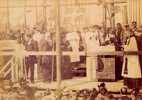 Laying
the Laying
theFoundation Stone |
 The
Foundation The
FoundationStone now |
Work on the site began in February 1897, and the Foundation Stone was officially laid by the Bishop of Southwell’s wife, Lady Laura Ridding, on 20 May 1897, Ascension Day. Messrs J Norris of Ascot were awarded the building contract after submitting a tender of £5,050.
The transfer from St Stephen’s, Bunkers Hill, did not stop with the patron saint and vicar - it included virtually everything which could be physically moved. The font had been acquired through a subscription raised in memory of Samuel Taylor Thraves, Bunkers Hill churchwarden 1882-1891, and a wooden top was presented in memory of George Francis Cooper who died in 1897. A portable wooden font was subsequently presented to the church in 1968. Other furnishings moved to Hyson Green included the oak eagle lectern, given in memory of Henry Francis McDonald, curate at Bunkers Hill, who died in Africa in 1878, and the pulpit, presented in memory of Samuel Middleton in 1881. Plaques from the old church were rehung on the walls of the new: the four on the west wall commemorate two Sunday School teachers, a warden and a choir member from Bunkers Hill.
Some items were not destined to stay long in the new church. In 1906 new choir stalls, carved from Austrian oak and wax polished, were given in memory of Tom Betts. They cost £118 4s, and the old ones were given away.
So complete was the transfer that the new church retained the status of Nottingham St Stephen. Whereas the iron church had always been regarded as part of Hyson Green, the new church kept its position as a Nottingham parish (despite being further from the centre of the city than St Paul’s, which was known as Hyson Green St Paul).
Although the foundation stone was officially laid in May 1897, it was another year before the new church was consecrated. Services continued to be held in the iron church, while the new church was rising in front of it. Eventually, on Ascension Day, 19 May 1898, the Bishop of Southwell consecrated the church. A substantial procession of robed clergy processed from the iron church to the new building, and the Bishop preached on a passage from Hebrews chapter 4. The first wedding in the new church was on 18 June that year.
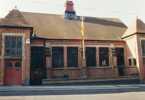 The
Church Hall The
Church Hall |
The church was full in its early years, and a new church hall was built on Gladstone Street in 1901. The existing parish room next to the church was extended in 1911. In 1912 there were 850 children on the Sunday School roll, and there were 138 baptisms and 2 confirmations. However, the living was worth only £50, which was supplemented both for the vicar and for his curates, by the Church Pastoral Aid Society.
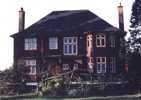 The
Vicarage The
Vicaragenow demolished |
During the 1920s a plot of land adjoining the church site to the south-west was acquired and a vicarage built (demolished 1990s), funded from the proceeds of the sale of St Thomas’s vicarage, Nottingham. The vicarage had a large front lawn. For some years a tennis club used the lawn, and it was an ideal site for bazaars and summer garden parties. At the entrance to the short path that led from the vicarage to the lawn were two busts, of Shakespeare and Milton, given originally to the third vicar, the Rev Jervis Twycross, by a milliner on Hyson Green. Their origin is unknown, but to avoid vandalism in the later 1980s they were taken to Southwell where they can still be seen in the garden of Bishop’s Manor.
Apart from new choir stalls in 1906 few internal changes were made to the church until the 1920s. In the early 1920s the PCC debated for some time the possibility of a replacement reredos. Several designs were drawn up, and the PCC finally accepted one of these at its meeting on 3 December 1923. This was dedicated by the Bishop of Southwell. The old chancel curtains were removed for use at Gladstone Street Hall.
Another change in the church was in 1928 when Mrs Fisher, mother of the late Vernon Fisher, gave a screen in memory of her son, which was erected on the south side of the chancel. It was dedicated on Ascension Day, but amended slightly in 1930. Fisher, a sidesman and Sunday School teacher, had died in 1927.
After the Second World War numbers dwindled and Gladstone Street Hall became superfluous to requirements. In 1950 a proposal was put to the PCC to sell the Hall. In the end Nottingham Education Committee offered to take a long lease and the matter dropped, but in 1963 the PCC again considered selling or leasing it. The New Testament Church of God offered £6,000, which was turned down as insufficient. However it was let in 1965 and it remained as commercial premises for small businesses until 1987 when it was sold.
As the character of Hyson Green changed the church and vicarage were both affected. Lead was frequently stolen from the church roof, and by 1975 the situation was becoming increasingly serious. In April the roof of the parish room annexe was maliciously damaged and the men’s toilet wrecked. Damage was reckoned at £500. In November the cross and brass vases from the Holy Table were stolen. The replacement cross and vases were themselves stolen in 1977. However, they were subsequently restored to the church after being found by a road sweeper in Sneinton.
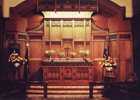 The
altar and reredos The
altar and reredosdestroyed by fire in 1977 |
Without any doubt the most serious trouble occurred in 1977. Between 15 and 17 August that year an arsonist entered the church and started fires at the altar and in the choir vestry. Fortunately the fires extinguished naturally, and damage was limited, but the blaze destroyed the Holy Table, the 1924 carved oak reredos, the surrounding carpet and kneeling stools, and most of the contents of the choir vestry. The whole interior of the church, including the organ, needed cleaning.
On Ascension Day 1979 a new sanctuary was dedicated by the Rev Colin Buchanan, Principal of St John’s College. The top step of the existing sanctuary area was removed to create greater level space around the new Holy Table. A new reredos was made to the designs of John Whitehorn depicting Alpha and Omega, the beginning and the end, and including a dove representing the Holy Spirit. With yet more break-ins following the fire, an intruder alarm was fitted to the church in 1977.
Funding was also made available in the wake of the fire to alter the rear of the church, and the west end of the church was converted into a lounge area. As a result the overall seating capacity was reduced for the first time since 1898.
With the redevelopment of Hyson Green from the 1970s, and with falling numbers at both St Stephen’s and St Paul’s, Southwell Diocese decided that it was appropriate to fund only one full time minister in Hyson Green. As a result, in September 1984 the Rev Glyn Jones was instituted vicar of both St Stephen’s and St Paul’s. In 1987 the two parishes were amalgamated as the joint parish of Hyson Green St Paul’s, and St Stephen’s, Nottingham.
With government and Church of England alike concentrating their attention on inner cities, the opportunity arose to transform the St Stephen’s site. Plans were drawn up to retain the church, but to clear the rest of the site including the allotments and the vicarage garden, to make way for a community centre and housing project. A detailed scheme was prepared by William Saunders and Partners, architects, and Peter Combellack, a Birmingham-based consultant, was appointed project manager with funding from the Tudor Trust. On 29 November 1989 a consultation day was held in the church, chaired by the Bishop of Southwell, to discuss the proposed scheme. This was not in the end accepted, partly because although the church building was to be retained it was to be reused for non-church purposes, with a worship area being created in a different part of the site.
Despite this setback the momentum was sustained. In the wake of reports about the church in the inner city, and following the establishment of the Church Urban Fund, Hyson Green was ideal territory for financial support. In January 1990 Allan Joyce, Architects, began work on a new plan, and the whole project was given a major boost when on 8 June 1990 Her Majesty The Queen, as Patron of the Church Urban Fund, and Prince Philip, visited St Stephen’s. They were received by the Lord Mayor of Nottingham, the Bishop of Southwell, and Sir Richard O’Brien, chairman of the fund, and they viewed various displays before unveiling a commemorative plaque.
A three-phase project was commenced on the Bobbers Mill Road site, overseen by New Beginnings (Nottingham) a registered charity launched in November 1990. Phase 1 was a housing scheme, which took up the space previously occupied by the vicarage back garden and the allotments. It consists of six two-bedroomed units, a five bedroom community house, and fourteen one bedroom apartments. The homes were fully occupied by March 1993. Phase 1 was funded by charitable giving (£160,000), a City Council grant (£163,000), and bank finance which was to be redeemed by unit sales and rental income. The homes were sold to the Leicester Housing Association, releasing significant funds for the later phases. The church retained perpetual nomination rights over the tenancies of ten of the units.
As this work progressed to phase 2 the parish room was demolished and The Vine was opened in the spring of 1994 by the Bishop of Southwell. The deteriorating condition of the church exterior meant that remedial work was needed at a cost estimated at approximately £70,000. Nottingham City Council was asked to support this work by making a 50 per cent grant under their Operation Clean-Up scheme. The remaining proposed alterations cost about £1 million of which about £125,000 was raised by the disposal of St Paul’s Church, which closed in 1994 to public worship and has since been converted into flats.
 The
Vine, and its The
Vine, and itsconnection to the church |
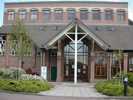 The
entrance to The Vine The
entrance to The Vine |
In preparation for Phase 3 the old church pews were removed in 1990, leaving just eleven (together with 220 chairs). However, the funding was not forthcoming, and the church has not been altered.
On 23 May 1998 St Stephen’s celebrated its centenary.






